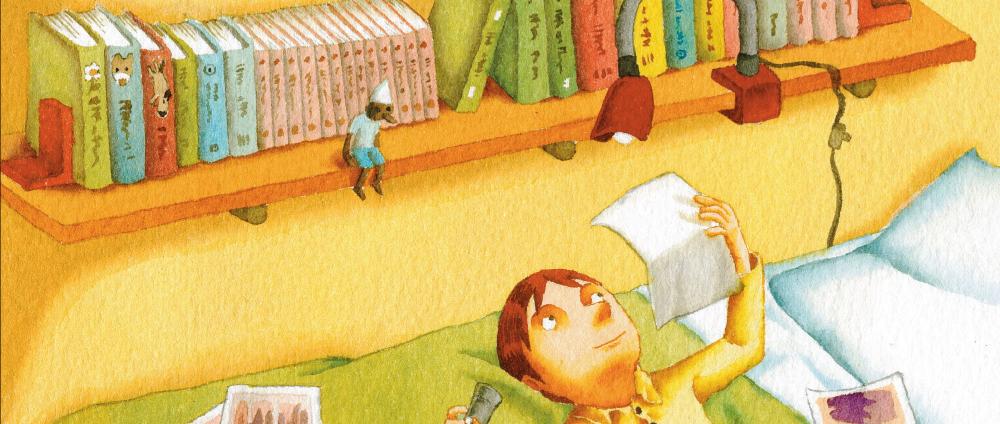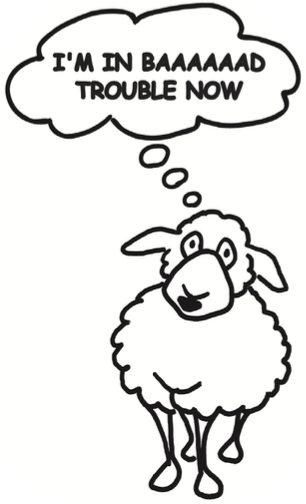
The Lost Sheep
- Identify with the lost sheep and imagine the warmth and love of Jesus, the good shepherd.
- Share Jesus' joy when he brings “lost sheep” back into the fold.
- Tell what the story shows us about God.
- Honor Jesus as the good shepherd who knows us and cares for us.
Session Outline
Leader Reflection
This unit offers the delightful experience of telling some of Jesus' parables and wondering together about these down-to-earth and surprising stories.
Jesus' parables are word pictures or analogies. In simple, vivid stories, Jesus gives us glimpses of what God's kingdom is like. Here are a couple of good rules of thumb for understanding parables:
In these analogies it's not that God or Jesus is the shepherd (or door, or father) but that this is what God is like.
Not every detail of the parable is necessarily important. The question should be "What's the main point?"
Luke provides the crucial background for the three unforgettable parables of chapter 15. The Jewish leaders were upset that Jesus was spending time with "sinners" and religious outcasts. Jewish religion in Jesus' day was all about religious purity and keeping the law of Moses. Hanging around with obvious sinners might, according to the prevailing view, sully one's own commitment (see Psalm 1), and it might give those sinners the idea that they were OK after all. So the motto was Stay away and remain pure!
In this simple story, Jesus makes an analogy between a shepherd and himself. That in itself is mildly surprising, since shepherds were considered rough-and- tough, unrefined citizens in that society. Jesus is saying, "Watch the shepherd in this story, and you'll begin to understand why I hang around with 'sinners.'"
A hundred sheep was an impressive number for that time, likely made up of the combined sheep of several neighbors, who took turns tending the flock. This, perhaps, helps explain why the shepherd is so concerned. These aren't just his sheep but also his neighbors' possessions and investments. His accountability is to the community.
Still, it seems counterintuitive that the shepherd would leave the ninety-nine out there, vulnerable, "in the open country," to go after the lost one. There may be some explanation that goes beyond the detail provided in the story that would make this action seem less reckless; for example, the shepherd may have gotten a substitute to fill in while he was gone. But that open question shouldn't sidetrack us. The main point is that the lost sheep becomes the shepherd's passionate focus.
The finding of the lost sheep prompts a celebration in the village, a fact that makes more sense when we consider the communal nature of caring for such a large flock.
In this case (but not always), Jesus makes the analogy of the story starkly clear: "In the same way there will be more rejoicing in heaven over one sinner who repents than over ninety-nine righteous persons who do not need to repent."
Ouch! What must that have sounded like to these religious leaders who were complaining about Jesus hanging around with sinners?
How would you feel if you were one of the religious leaders listening to this parable?
How would you feel if you were one of the “sinners” listening to this parable?
Do the “righteous” really need no repentance?
How might this parable change the way you see and relate to your kids, neighbors, coworkers, and others?
Be aware that some children in your group may be feeling “lost”—due to divorce in the family, disabilities, lack of popularity, conflicts within families or peer groups, and the like. This story may be the only really good news they hear all week.
Emphasize the passion of the shepherd for the lost sheep. In this parable, heaven (God) isn’t about counting and numbers; it’s about the single lost individual.
As you focus together on the parables for this unit, it’s especially important that you let the kids do the work. Don’t try to over-explain or nail down every detail. Instead, let the parable itself prompt the sense of wonder and surprise that’s inherent in it.
Steps
Over-the-door cloth shoe organizer, optional
Mini notebooks
Today you begin something special and new! Think of yourself more as a listener than as a leader. Together with the children in your group, you will sit at the feet of Jesus, discovering God’s love in fresh new ways and being transformed by the Holy Spirit.
Your role is to help your group get swept up in this story of God’s love. It’s a story that begins in the pages of Scripture and continues in our lives today. As you explore Bible stories together, you can help members of your group find their place in God’s family and in the world. One of the ways you can do that is by creating a warm, inviting atmosphere where all present can pause from their busy, noisy lives to meet with God. Help the kids see your time together each week as special and important. Expect them to be changed by the stories they hear and the time they spend with God. Model that kind of expectancy in your own life as you grow in Christ together!
Arrive early to set up everything you’ll need for the session before kids begin to appear. Have the Dwell CD playing softly in the background as you greet each member of your group with a friendly smile and learn their names. Make it your goal to memorize every new name by the end of the gathering time.
Give each member of your group a mini notebook and pencil and encourage them to keep it with them throughout today’s session (you’ll let them know how to use it a little later on). If you’ll be making mailboxes from a shoe organizer, set out markers and blank note cards for everyone to use to make name cards as they arrive.
Also use this time to learn a little bit about each person in your group. Here are some questions you could ask:
- What school do you attend?
- What’s your favorite flavor of ice cream?
- What was the best thing that happened to you this summer?
- Do you have a pet?
- What sports do you like?
Let your curiosity keep them busy talking until the name cards are finished. If time is tight, welcome everyone and get the session started while the kids decorate their name cards and then staple them to a pocket. Let the group know how excited you are to be their leader and to grow in faith with them this year. Express your hope that this meeting place will be a space where each feels welcome to share their stories, questions, and ideas, to experience God’s love and presence, and to grow into the person God is calling them to be.
Tell the group that the first few minutes of your time together each week will usually involve sharing your own stories in some way, as you get ready to hear God’s story. Choose one of following questions to ask your group:
- Name something you always seem to lose. Where is the funniest place it has turned up?
- What is the most valuable thing you’ve ever lost? What do you regret most about losing it?
- Tell about a time when you were lost. What did you do? Who came to find you?
To get the ball rolling, start by answering the question yourself.
We take time to explain the attitude of the Pharisees because it’s exactly the opposite of the gospel truth. As Reformed Christians we believe that God is the One who initiates our relationship with him. Like the good shepherd in the story, God saves us not because we impress him with our goodness but because we are lost and because Christ has compassion on us.
Story symbol, session 1 printable page
When everyone (who wants to) has had the opportunity to answer, point out that each of you has experiences and stories that make you unique but that you also share a common story that binds you together—it’s the story of God’s amazing love, shown to you through Jesus Christ! Let your group know that this week, and every week, you’ll be hearing a little more of that story
To help quiet your thoughts and open your hearts to God’s Word, teach kids this short prayer in sign language: “Speak, Lord, your people are listening.”
This is the prayer you’ll offer for the rest of the unit each time you enter the story. When everyone has mastered the signs, say the prayer together twice: once verbally and in sign language, and a second time in sign language only.
Have the group take out their Bibles, and explain that today you’ll be sharing a story that Jesus told to a crowd of tax collectors, “sinners,” and Pharisees. It comes from Luke 15 and also includes some description Jesus used, as recorded in John 10. Ask whether anyone would like to share what they know about tax collectors, “sinners,” or Pharisees in Jesus’ time. Pause to listen for their answers. Then encourage your group to use their notebooks to jot down things they wonder about or anything that catches their attention as you share the story.
The story follows:
Our story begins with two groups of people who lived in Jesus’ time: the Pharisees on the one hand and the tax collectors and “sinners” on the other.
The Pharisees were religious leaders who wanted to do things “right.” In fact, the Pharisees were so good at being “good” that some of them self-righteously figured God loved them more than anyone else.
Once, a bunch of tax collectors and “sinners” gathered around to hear Jesus teach. At least some of them were probably robbers, addicts, cheaters, or violent outlaws. The Pharisees were upset that Jesus would even talk to this motley, low-life crowd. “Jesus is always spending time with those troublemakers—he even eats with them!” the Pharisees grumbled.
I wonder why the Pharisees were so upset. How might we feel if Jesus were to come today and spent his time with murderers and drug addicts instead of with Christian leaders? (Pause for responses.)
The Pharisees thought the tax collectors and “sinners” were a lost cause—and they were pretty sure God thought so too.
(Lean in and whisper the next line conspiratorially.) But they were wrong!
So Jesus told this story to help them see people the way God sees them, and to let them know about God’s incredible love.
(Set down your Bible and this script for a moment and turn to the board/newsprint. Quickly sketch the story symbol for today’s story before continuing. Or use the symbol from the printable page.)
Once there was a shepherd who took very good care of his sheep. He led them all over the mountains of the region later known as Palestine, taking them to the sweetest grass and the freshest water.
This shepherd went ahead of the sheep on the path. He pulled out poisonous plants and tossed aside rocks and branches that might harm the flock. He carried a heavy club to ward off animals that might try to attack the sheep.
He also used a long, thin staff with a curve at one end. If a sheep fell into a hole or began to wander off, the shepherd would reach for the animal with the crook of his staff and pull the sheep gently back to safety.
The sheep loved their shepherd. They knew his voice and trusted him. Wherever he walked, the sheep would follow behind. He watched them carefully and counted them often to make sure all one hundred were safe.
But one day a single sheep drifted away and left the flock without the shepherd noticing.
The sheep drifted farther and farther away until he could no longer hear the shepherd’s voice. The lost sheep stumbled into a ravine and couldn’t climb out.
The shepherd was taking the flock back along the path toward home when he noticed that one of the sheep was missing. He stopped and looked around at the other sheep; they were tired from the long day of grazing. Then he looked back at the trail.
The shepherd could have gone home with the other ninety-nine sheep and put them all safely to rest. But he loved that missing sheep, and he wouldn’t leave it alone to die. So he decided to search for it.
What do you think—was the shepherd being fair to the other ninety-nine? Who might have been keeping them safe? Why was that one sheep so important to the shepherd? (Pause for responses.)
The shepherd made the flock lie down before he walked off to look for the lost lamb. He searched for a long time, stumbling over rocks and tearing his coat on thorns. Finally, the shepherd heard a faint bleating sound in the distance.
His heart leaped with hope as he scrambled down the steep slope of a hill toward the sound of a sheep’s “baaah.” There, at the bottom of the ravine, he found his lost sheep—its wool matted and full of thorns, its ear torn and bleeding. The sheep was shaken, hurt, and unable to walk.
The shepherd gently pulled out the brambles and thorns and put medicine on the sheep’s cuts. Then he hoisted the heavy sheep up onto his shoulders and slowly climbed out of the ravine.
All this time his heart was bursting with joy. He had found his lost sheep!
What words could you use to describe the shepherd? (Pause for responses.)
When he arrived at the place where the rest of the flock lay sleeping, the shepherd counted them all again. He laughed with relief when he counted all one hundred sheep. Still carrying the injured sheep, he led the flock home in the dark, settling them down in their pen for the night.
The shepherd was so thrilled to have found his lost sheep that he threw a party for his friends and neighbors. “Let’s celebrate!” he invited. So they danced and ate under the stars, delighted that the one missing sheep was back in the fold!
(Pause for a moment, smiling at the good news, before continuing.)
After he had finished telling this story, Jesus said, “Like the shepherd, God and the angels also sing and shout for joy whenever one sinner comes back to God! God is happier over one lost person who returns than over ninety-nine people who never went astray.”
Remind the group that the crowd who had been listening to Jesus tell this parable included some Pharisees—good religious leaders who always obeyed the law—and some sinners who cheated, stole, and perhaps even murdered or acted violently. Wonder together about how each of these groups might have reacted to the story Jesus told.
Story frames printable pages, one per pair or child
Ask the children what they noted or wondered about during the story. What surprised them or stood out for them? Listen as they share and then briefly discuss this question:
What does this story tell us about God’s love?
You may also want to ask the children what they think the word “sinner” means in this context and talk together about how all of us are sinners—even those who are good, religious people who obey the law (like the Pharisees). The good news of this story is that God chases after sinners like us and forgives us, welcoming us back with joy.
Hand out copies of the story frames, along with crayons, markers, or pencils. Give one page to each pair or individual (depending upon how large your group is) and encourage the children to create a graphic novel/comic strip that depicts what happened during that portion of the story. Assure everyone that stick figures are perfectly acceptable! Ask kids to use thought and dialogue bubbles to imagine what people (and animals) might have been thinking or saying. If they run out of ideas, encourage them to look up the Bible passages that are listed at the top of each of the printable pages.
Allow everyone to work for 8-10 minutes. Then gather the group back together and include everyone in retelling the story in sequence, with each person or group sharing their work. You may want to display each set of story frames on the wall (using tape or poster putty), or you could spread the story frames across the table or floor and have everyone gather around.
Thank each person and group who shares, and note anything in their story frames that might spark conversation within the group. Wrap up this step by addressing one or more of the following questions or thoughts to help your group consider the way in which this story intersects with your lives:
- In what situation have you have felt like the lost sheep in this story?
- Can you think of a time when Jesus rescued you, comforted you, or called out to you?
- Why do you think Jesus wanted us to hear this story today?
Be patient as you wait for answers. Some kids may be reluctant to share personal stories about times when they’ve felt distant from or particularly close to God. That’s OK—don’t push. They’re thinking about the questions even if they aren’t comfortable sharing. Receive every answer with respect, and in time your group will begin to open up.
Demonstrate that this is a safe place to share ideas and experiences by listening well and offering your own reflections along with theirs.
Storymark 1
Memory Challenge printable page
Dear Family letter (printable page or email version), one per child
Distribute Storymarks and explain that they’re designed to fit in their Bibles and mark the location of each week’s story. Point out the devotional ideas on the back of the Storymark and ask them to try one or both of them this week. Let them know that you’ll be doing the same.
Give the children 3-5 minutes to fill in the first part of their Storymark and to pray silently, using the prompts in the “My Prayer” section.
When everyone has finished, close by asking your group to stand to read Psalm 23 aloud together as a prayer. End with “Amen.” Tell the group that for the next six weeks they’ll be memorizing this psalm. Challenge them to work on verse 1 during the coming week. If you have time, you may want to introduce the memory work by playing “My Shepherd Is Near” from the Dwell CD. Your group will enjoy the rhythm, and the rap will make the words easier for them to remember.
Thank your group for a great first session! Remind children to take home their Storymark and a copy of the unit Memory Challenge and to slide their notebook and pencil into their “mailbox” (or hand them to you) for next week. Challenge them to do some of the other “sheep” focused activities during the week.
If you've purchased God's Big Story cards for your families, talk a bit about them and how they can be used at home. Direct them to search for today’s symbol in the box. Their family may want to do some of the activities suggested on that card as part of their family devotions this week. Connect with families this week with the Dear Family letter (printable page or email version) about this unit.
Easy Extras
slips of paper or note cards
pencils
bowl
Play a get-to-know-you game. Have each person write one interesting or surprising thing about themselves on a slip of paper or index card. Toss all of these into a bowl and take turns pulling them out, reading what’s written, and guessing as a group who wrote it. When the person’s identity is revealed, ask a few questions so that everyone gets to hear the story behind the statement.
shawl
staff
This activity could be used in place of Step 2: Entering the Story.
Instead of using the story script in Step 2, you may prefer to tell the story from the viewpoint of the shepherd. Use the beginning and end of the script to establish the context, and then develop your own narrative. Make the transition from being the narrator to being the good shepherd by wrapping a shawl around your head or by picking up a large staff. Adding a simple prop will provide a visual cue that you are changing character.
box of costumes and props—a shepherd’s staff, fuzzy blankets for the sheep, a curling iron or wooden table spoon for the microphone, and so on.
This activity could be used in place of Step 3: Living into the Story.
Your group may enjoy creating a newscast and reporting “live from the streets of Jerusalem” to talk to the tax collectors and Pharisees and “live from the hills of Judea” to interview the shepherd and his lost sheep. Brainstorm a list of people and animals that could be interviewed and the questions they’d like to ask. Then, with you serving as the reporter, “film” some of the following:
- Ask the tax collectors why they’ve gathered to hear Jesus.
- Invite the Pharisees to tell you what they have against tax collectors.
- Ask Jesus why he thinks telling this story might be helpful.
- Interview the shepherd about caring for his flock—and the sheep about being cared for.
- Do a “breaking news” sequence on the shepherd searching for his lost sheep. You might invite someone to pantomime the shepherd while you narrate the events you’re seeing.
- Be sure to film the big celebration when the one lamb is found!
- Summarize the news by saying something like this: “There you have it, folks. God is like the good shepherd who is eager to save every lost sheep—I mean, person—no matter how far it has strayed. Thank you for joining us tonight for this special report. And we thank the helpful witnesses and the brave camera crew who climbed the mountains of Judea to bring you this important story!”
Between “takes” you can talk with the group about what will happen in the next scene. Make sure everyone who is being interviewed feels as though they have something worthwhile to say. Kids of this age can be very creative when it comes to acting out stories and imagining answers to questions that an
interviewer might ask. They may not even realize that they’re discovering the meaning of the story as they go through this exercise! If you find that someone can’t think of anything to say in response to a question, just rephrase the question. If that doesn’t work, say “Cut” and coach the participant a little before beginning again. Or you can simply work this into the story by saying something like, “Wow, folks, it seems as though she’s speechless—it’s been that kind of night!”
Include as many people as possible in each scene—as extra tax collectors or Pharisees, the camera crew, or sheep. If you have a box of costumes and props—such as a shepherd’s staff, fuzzy blankets for the sheep, a curling iron or wooden spoon for the microphone—that would make this option even more fun!
Wrap up with the questions included in the original step.




